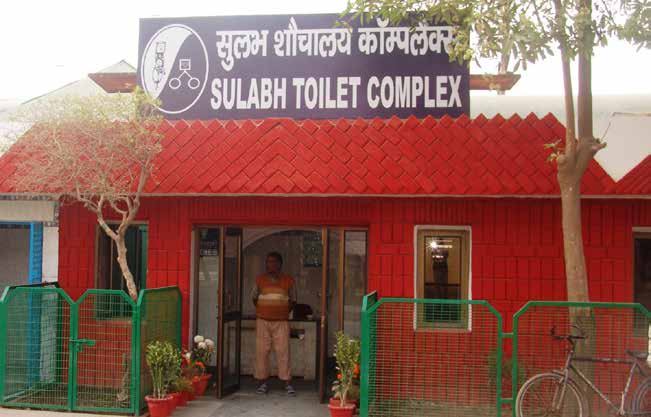Dr. Bindeshwar Pathak, founder of Sulabh Sanitation and Social Reform Movement, is India’s foremost sociologist and social activist. He believes the toilet is a tool for social change. He has received a great deal of national and international recognition for his work, including the Stockholm Water Prize in 2009. Here’s an edited excerpts from an e-mail interview by Samarth Pathak, program offi cer, Ananta Aspen Center.
Swachh Bharat Abhiyan: How to make it work?
The framework of achieving the target was provided by the Prime Minister Narendra Modi himself, who launched Swachh Bharat Abhiyan on 2nd October 2014. It’s target is to provide toilets for all 130,955,209 households in 6, 40, 867 villages, 5,924 blocks/taluks/ tehsils and 690 districts by 2019. To achieve this goal the following steps are required:
Technology
Two pits pour fl ush compost toilet technology which I invented in 1968-69 and popularized in the name of Sulabh Shauchalaya is a feasible solution. Sewerage and septic tank technologies are costly in construction and maintenance. Therefore, implementation of these technologies is not viable. The Sulabh technology of two pit pour fl ush compost toilet is eco-friendly, appropriate, affordable, indigenous and culturally acceptable. With this technology, human waste is recycled and converted into bio fertilizers to be used in fi elds and gardening and only a liter of water is required to fl ush. We have so far installed 1.3 million individual toilets throughout the country and 8000 public toilets on “pay & use” basis at public places which are functioning very well in different regions of India. Sulabh has also constructed and maintained toilets in Kabul, Afghanistan and Bhutan.
Financing
The cost of a functional toilet is around Rs. 20,000. Financing can be done by availing of subsidy from the government added to which would be benefi ciaries’ own contributions which they can arrange by taking loans from banks or micro fi nancing institutions.
Manpower
To achieve the goal 50,000 motivators and 1.5 lakh masons will need to be trained to implement, maintain, and follow up the construction of toilets. Motivators will also go house to house, make people aware, educate and help the benefi ciaries obtain loans from banks and subsidy from the government.
India’s Key Sanitation Challenges
 The most important challenge that is faced by an average Indian is lack of awareness and realization of the importance of having the facility of a household toilet. The absence of a toilet necessitates open defecation in rural areas and in outlying and neglected urban areas. The lack of fi nance is a challenge faced by only the poorest of the poor and in urban areas by the slum dwellers. It has been noted that even where fi nance is available, construction of a toilet is not a priority for many because of poor awareness. Further an average Indian seeks expenditure in cash for construction of a toilet but does not like t spend his own money on it. Here, the government can step in by way of implementation of the loancum subsidy scheme for construction of toilets. But fi nancing is not always forthcoming because of procedural delays and lack of priority. The other issues of concern are the unrealistic estimates worked out or shortage of funds with the government. Due to this, intended benefi ciaries either do not fi nd the scheme attractive enough or avail fi nance but fail to utilize it fruitfully. This results in construction of poor quality or incomplete toilet facilities.
The most important challenge that is faced by an average Indian is lack of awareness and realization of the importance of having the facility of a household toilet. The absence of a toilet necessitates open defecation in rural areas and in outlying and neglected urban areas. The lack of fi nance is a challenge faced by only the poorest of the poor and in urban areas by the slum dwellers. It has been noted that even where fi nance is available, construction of a toilet is not a priority for many because of poor awareness. Further an average Indian seeks expenditure in cash for construction of a toilet but does not like t spend his own money on it. Here, the government can step in by way of implementation of the loancum subsidy scheme for construction of toilets. But fi nancing is not always forthcoming because of procedural delays and lack of priority. The other issues of concern are the unrealistic estimates worked out or shortage of funds with the government. Due to this, intended benefi ciaries either do not fi nd the scheme attractive enough or avail fi nance but fail to utilize it fruitfully. This results in construction of poor quality or incomplete toilet facilities.
Cleaning India: An Imperative
Cleaning India is necessary because as far as toilet related sanitation is concerned, the lack of facilities has led to the obnoxious practice of open defecation. Poor cleanliness also spreads diseases like diarrhea, worm infestation that in turn adversely affect economic productivity. A cleaner India is bound to be healthy and a healthy India will be prosperous due to the creation of a disciplined and productive work force. Moreover expenditure over health will also be substantially reduced.
Mobilizing Community Support
What is required is to boost health education on observance of elementary hygiene. Inculcating habits of cleanliness amongst children automatically puts pressure on parents to observe cleanliness in their homes. Forming school sanitation clubs causes peer pressure for hygiene which is readily accepted by children. Also it is in these clubs that elder boys sensitize the younger ones and motivate them by observing habits of cleanliness.











the description is sketchy. i want clear design of the toilet and its costing with graphics. i am doing some social work for making rural toilet blocks in govt. schools FUNCTIONAl.